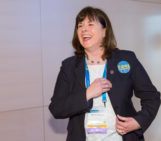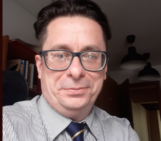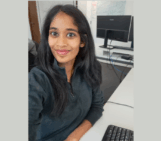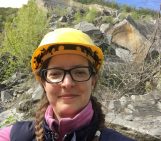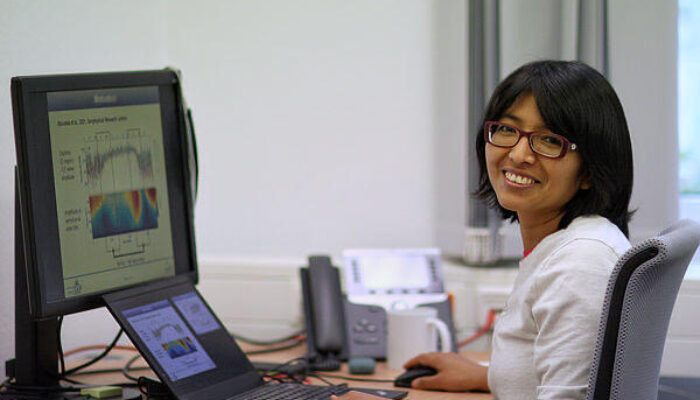
Hi Liliana. Welcome to GeoTalk! Can you tell us a bit about yourself and your background?
Hi, I was born in the highlands in Peru. This gave me the advantage of living more in contact with nature. Since I remember, I was fascinated about the shape of the clouds, the sounds of the wind in the mountains or trees, the sounds of the rain and what they do to our surrounding; the lightning flashes and thunderstorms, the sky’s colour around sunrise and sunset, the starry sky. I cannot think of a specific thing but experiencing all these together somehow inspired me to pursue a career in physics.
I did my undergraduate studies in Peru at the San Luis Gonzaga National University. During my last year, I contacted researchers from the Presbyterian University Mackenzie, Brazil. After discussing with the PI (Jean-Pierre Raulin), I was invited to join his research team and work in a project called SAVNET (South American VLF NETwork). It was a wonderful experience in Brazil and I completed my Master in Space Science and Applications in 2015.
After that, I did my doctoral studies at the Sondakylä Geophysical Observatory, University of Oulu, Finland. I think Finland gave me many opportunities. For example, I grew my network, learnt new 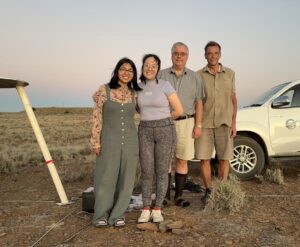 techniques, did internships in different research organizations (UK, Czechia, and Japan), attended conferences, and published research articles as the first author. I always felt like Finland was like a second home for me.
techniques, did internships in different research organizations (UK, Czechia, and Japan), attended conferences, and published research articles as the first author. I always felt like Finland was like a second home for me.
At the end of my doctoral studies, Dr. Martin Fullekrug from the University of Bath motivated to apply for an individual fellowship of the Marie Skłodowska-Curie Actions. The project we submitted for evaluation was named ORACLE and it was funded. Thanks to the grant I am able to develop my career, acquire new skills, and perform multidisciplinary and beyond state-of-the-art research.
The ionosphere comprises the upper layer of the Earth’s atmosphere. What makes this distant region so interesting to study?
My research focuses on studying the dynamics of the D-region of the ionosphere, which is located between approximately 60 and 90 km altitude.
The D-region, also know as the lower ionosphere, is a complex environment. It is the region where space and space weather phenomena couple into the Earth’s atmosphere. It is also the region where turbulence and chemistry are important.
In comparison, at higher altitudes the chemistry is not very important.
The D-region is also the lesser known part of the atmosphere (also know as the ignorosphere) because in situ measurements are scarce. This region is too high to use meteorological balloons and too low to use satellites. The use of sounding rockets to measure the D-region properties is an option. However, this kind of technique cannot be used to have continuous measurements. In my case, I use the propagation of Very Low Frequency (VLF: 3-30 kHz) radio waves to remotely monitor the D-region of the ionosphere. Specifically, my research seeks to provide new knowledge on the dynamics of the lower ionosphere, as well as the effects on this region caused by galactic, solar, and atmospheric phenomena.
You were involved in the discovery of new radio waves associated with bursts of lightning. Could you tell us how the two phenomena are related?
We are not sure whether the two phenomena are related or not. Actually, this is the beauty of this new observation. What we found is that in addition of familiar (Very Low Frequency) VLF emissions, like the “chorus” or “hiss” emissions, we observed banded structure (BS) VLF emissions at frequencies not normally monitored. In other words, at frequencies higher than 10 kHz.
A major reason for the limited number of reports on VLF emissions at higher frequencies is that atmospherics (“sferics”: VLF emissions from lightning) obscure them. Applying digital processing tools, we remove the strongest impulsive sferics of our data. In this way, we uncovered a new type of high frequency VLF emission. This result raised questions on whether the BS VLF emissions recorded in Finland are formed in the magnetosphere, as in the case of a VLF wave type called structured “auroral hiss”, or if the emissions are formed inside the Earth-ionosphere waveguide, as in the case of interference of different modes of propagation of lightning VLF emissions. To answer this question, we are looking for similar findings but using data from other VLF receivers.
From extra-terrestrial events to the more Earth-bound, a lot influences the ionosphere. With so much going on above our heads, what is one thing about your field that you wish more people would know about?
We should remember that we humans owe our origin, evolution, and present existence to the Earth and its surrounding space, from the atmosphere to the limits of the universe. For example, the Earth is neither too close nor too far from the Sun. This suitable distance allows us to live and develop.
However, there are hazards able to affect the ionosphere and the magnetosphere, which are two important parts of our terrestrial environment. The occurrences of hazards are uncertain, yet imminent.
Consequently, serious efforts should be made (investments of time and resources) to prevent and mitigate risks. History shows us that proactive actions cost much less than post troubleshooting or reconstructions.
Your passion also extends to the scientific community: recently, you became ECS Representative for the Division on Solar-Terrestrial Sciences. Why do you think engaging with your research community is important?
I learnt a lot and gained experience by interacting with the scientific community at different levels, with junior colleagues, peers, and senior researchers, at outreach activities or scientific meetings like the EGU General Assembly (GA). Indeed, EGU’s GA is one of my favourite scientific meetings during the year. Since the first time I attended it in 2019, I felt welcome and integrated.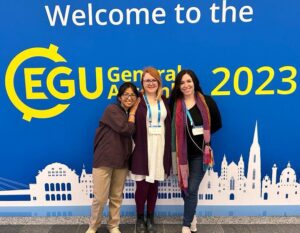
From my experience, research is collaboration, interdisciplinarity, and has a social aspect. Now, I reach a level in which I can contribute and help others grow their network, be aware of opportunities – like job offers -, improve their skills, and enjoy the wonderful EGU General Assembly experience. I am very enthusiastic about organizing campfires for ST-ECSs with the help of the ST-ECS team. With the ST-ECS team we are also planning networking activities for next year’s General Assembly.

